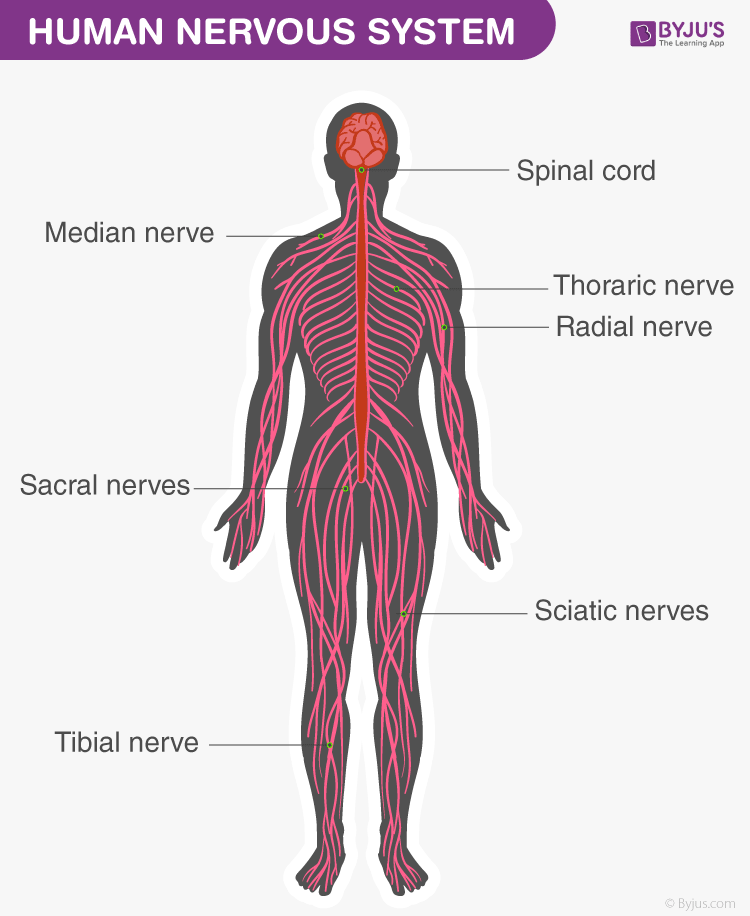Living organisms adapt to their moves and positions in response to the environmental changes for their protection or to their advantage. When an entity reacts to the changes in its surroundings, it is referred to as stimulus while the reaction to the stimulus is referred to as a response. Common stimuli are sound, light, air, heat, smell, taste, water and gravity.
Think of burning your finger of fracturing your bone without any pain sensation. It may certainly sound like a superpower or an ideal situation, however, when it comes to the standpoint of survival, it can be disastrous.
The characteristic behaviour of living entities is to respond to stimuli with the intervention of the nervous system. It is an organ system ascribed to send signals from the spinal cord and the brain throughout the body and then back from all the body parts to the brain. The neuron acts as the mediator and is the basic signalling unit of the nervous system.
Pain is the body’s way of letting us know that something is not right. It can prevent further injuries or push us to seek medical attention. Moreover, all of this is possible because humans can respond and react to stimuli due to control and coordination among the various organs and organ systems.
Control and Coordination in simple multicellular organisms take place through only the Nervous system which coordinates activities of our body. It is the control system for all our actions, thinking, and behaviour.
Refer more: Control and Coordination
Let us have a detailed look at the nervous system notes to explore what is the nervous system, and the different functions of the nervous system with the help of diagrams.
Table of Contents
- What is the Nervous System?
- Human Nervous System Diagram
- Central Nervous System
- Peripheral Nervous System
- Neuron
- Nerves
Recommended Video:

What is the Nervous System?
The nervous system or the neural system is a complex network of neurons specialized to carry messages. The complexity of the nervous system increases as we move towards higher animals.
For instance, cnidarians such as jellyfish have relatively simple nerve nets spread throughout their body. Crabs have a more complicated nervous system in the form of 2 nerve centers called dorsal ganglion and ventral ganglion.
As we move further up the ladder, higher organisms such as vertebrates have a developed brain. Moreover, it is one of the most complicated structures in the animal kingdom, containing billions of neurons, all intricately connected.
In the human body, the neural system integrates the activities of organs based on the stimuli, which the neurons detect and transmit. They transmit messages in the form of electrical impulses and convey messages to and from the sense organs. Thus, the nervous coordination involves the participation of the sense organs, nerves, spinal cord, and brain.
Also Read: Creutzfeldt-Jakob Disease
Human Nervous System Diagram

Diagram of the Human Nervous System
One of the most complex organ system to ever evolve, the human nervous system consists of two parts, namely:
- Central Nervous System (consists of the brain and spinal cord)
- Peripheral Nervous System (includes all the nerves of the body)
Central Nervous System
Central Nervous System (CNS) is often called the central processing unit of the body. It consists of the brain and the spinal cord.
Brain
The brain is one of the important, largest and central organ of the human nervous system. It is the control unit of the nervous system, which helps us in discovering new things, remembering and understanding, making decisions, and a lot more. It is enclosed within the skull, which provides frontal, lateral and dorsal protection. The human brain is composed of three major parts:
-
Forebrain: The anterior part of the brain, consists of Cerebrum, Hypothalamus and Thalamus.
-
Midbrain: The smaller and central part of the brainstem, consists of Tectum and Tegmentum.
-
Hindbrain: The central region of the brain, composed of Cerebellum, Medulla and Pons.
Also read: Human Brain
Spinal Cord
The spinal cord is a cylindrical bundle of nerve fibers and associated tissues enclosed within the spine and connect all parts of the body to the brain. It begins in continuation with the medulla and extends downwards. It is enclosed in a bony cage called vertebral column and surrounded by membranes called meninges. The spinal cord is concerned with spinal reflex actions and the conduction of nerve impulses to and from the brain.
Peripheral Nervous System
Peripheral Nervous System (PNS) is the lateral part of the nervous system that develops from the central nervous system which connects different parts of the body with the CNS. We carry out both voluntary and involuntary actions with the help of peripheral nerves.
Also refer: Peripheral Nervous System
PNS includes two types of nerve fibers:
- Afferent nerve fibers – These are responsible for transmitting messages from tissues and organs to the CNS.
- Efferent nerve-fibers – These are responsible for conveying messages from CNS to the corresponding peripheral organ.
Classification of the peripheral nervous system:
Somatic neural system (SNS): It is the neural system that controls the voluntary actions in the body by transmitting impulses from CNS to skeletal muscle cells. It consists of the somatic nerves.
Autonomic neural system (ANS): The autonomic neural system is involved in involuntary actions like regulation of physiological functions (digestion, respiration, salivation, etc.). It is a self-regulating system which conveys the impulses from the CNS to the smooth muscles and involuntary organs (heart, bladder and pupil). The autonomic neural system can be further divided into:
- Sympathetic nervous system
- Parasympathetic nervous system
Neuron

A Neuron is a structured and functional unit of the nervous system and unlike other cells, neurons are irregular in shape and able to conduct electrochemical signals. The different parts of a neuron are discussed below.
- Dendrite stretches out from the cell body of a neuron, and it is the shortest fibre in the cell body.
- Axon is the longest thread on the cell body of a neuron and has an insulating and protective sheath of myelin around it.
- Cell body consists of cytoplasm and nucleus.
- Synapse is the microscopic gap between a pair of adjacent neurons over which nerve impulses pass, when moving from one neuron to the other.
Explore more: Placebo Effect
Nerves
Nerves are thread-like structures that emerge from the brain and spinal cord. It is responsible for carrying messages to all the parts of the body. There are three types of nerves. Some of these neurons can fire signals at speeds of over 119 m/s or above 428 km/h.
- Sensory nerves send messages from all the senses to the brain.
- Motor nerves carry messages from the brain to all the muscles.
- Mixed nerves carry both sensory and motor nerves.
Also read: Nerves
Cranial nerves begin from the brain as these nerves carry impulses to start from the central nervous system. Certain cranial nerves belong to the group of mixed nerves while certain ones fall under sensory nerves. Spinal nerves originate from the spinal cord. All the spinal nerves carry impulses to and from the central nervous system and these are part of mixed nerves. The above nervous system diagram depicts the various nerves arising from various parts of the body.
Learn more in detail about the Human Nervous System with diagrams or any other related topics by referring to the nervous system notes provided at BYJU’S website. Download BYJU’S app for further reference.
Frequently Asked Questions
What are the two divisions of the nervous system?
The human nervous system controls all activities of the body in a quicker fashion. It can be divided into the central nervous system and peripheral nervous system. The central nervous system includes spinal cord and brain and the peripheral covers the nerves branching from spinal cord and brain.
What are nerves and neurons?
Nerves are thread-like structures that emerge from the spinal cord and brain. These nerves are actual projections of neurons. A neuron is a basic structural and functional unit of a nervous system that conducts electrochemical signals.
What are cranial nerves?
The nerves that extend throughout the body on both sides and emerges directly from the brain stem and brain are called cranial nerves. They carry information from the brain to other parts, primarily to the neck and head.

Hello Byju’s I need to chat with you to clarify a doubt. Your app is so good
Really Byjus is a very good application in the case of study in a systematic knowledge so Byjus achievement is great
Thank you for helping with this concept, it gave me better information than other websites.
THIS IS SERIOUSLY A NICE SITE FOR KNOWLEDGE.
Thanks a lot for helping me
Thanks a lot for helping
This app is very awesome and also help me in doing my homework ..
Actually I need more of these to pass my test thanks for sharing these notes
I am really grateful to you about these
Bye
Byju’s always help me a lot. .This platform is really great.